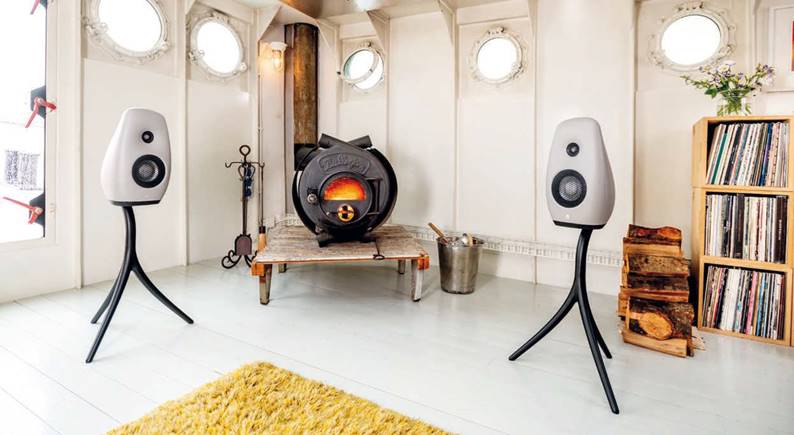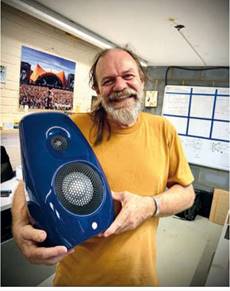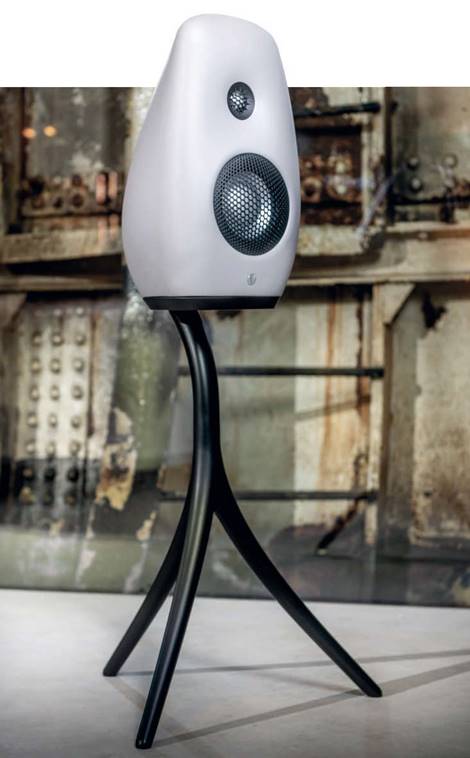Vivid Audio Kaya S12 Review
The big brain behind Vivid
Audio – Lawrence ‘Die’ Dickie (pictured holding an Kaya S12 on page 50) – once shared an anecdote with me some years back. When Vivid Audio first launched its products, the company showed off its distinctive, unique looking, loudspeakers at a hi-fi show, the first reaction from the first member of the public to walk in the room was, “Oh no, not again!” Presumably he comes from a long line of people who had seen it all before, tutting at everything from the wheel (“It’s just a square with the edges knocked off!”) to the Apollo space program (“We’ve had fireworks for years… what’s the big deal?”). However, one of Vivid Audio’s real-world issues is people like the idea of truly distinctive looking loudspeakers but end up buying bland boxes ‘to play it safe’. The Kaya line is in part a way of addressing the need to make a loudspeaker cabinet that doesn’t ‘play it safe’ for sound (and sonic) reasons, while making a more universally acceptable design, and the Kaya S12 standmount loudspeaker is the smallest and most domestically-chummy of the whole range. Read our Vivid Audio Kaya S12 Review.
There’s something very organic to the shape of the Vivid Audio Kaya S12, especially on its dedicated three-point stand. This is where the design is so clever because threefooted speakers have traditionally either looked like truncated Ikea living room lighting systems or something out of The War of the Worlds (but usually with fewer death rays). By giving those three legs a gentle concave, they look like the speaker grows out of them. That 12 litre RIMcast polyurethane resin cabinet looks less like a loudspeaker and more like a flower or a large seedpod.
“The big thing from this little speaker, however, is the relative absence of distortion.”
The injection-moulded enclosure shape of the Kaya S12 is not just there to creep out fans of Invasion of the Body Snatchers, however. The front baffle gives the tweeter a gentle horn-loading and the overall shape creates the ideal rear chamber size for both treble and mid-bass units, aided by the tapered tube reflex first used in Vivid Audio’s behemoth Giya G1. It’s also designed from the outset to reduce internal cabinet resonance, making it an ideal platform for the drive units to do their stuff unimpeded by the box itself.
Of course, the cabinet making virtually no impact on the sound of the loudspeaker means more of the sonic heavy lifting is placed on character of the drive units; to the point where if they have a ‘character’, it will be thrown into sharp highlight because the cabinet leaves few places to hide. Unlike the majority of loudspeaker ‘builders’, Vivid Audio is one of the few who make their drive units; in the case of the Kaya S12, the company’s 26mm D26 Tapered Tube-loaded carbon-reinforced catenary dome tweeter used throughout the line is joined by the long-throw 100mm C100L alloy dome/cone driver designed specifically for the Kaya S12.
Pretty much every aspect of what goes into making a drive unit comes under Dic’s scrutiny, and those long-standing ‘well, we’ve always done it that way’ facets of loudspeaker driver engineering are stress-tested and – if found wanting – a better way of doing things is found. For example, the internal architecture of the enclosure features a unique tapered absorber that surrounds the rear of the mid-bass driver. Each of the radial slots formed by the deep ribs in this absorber is itself filled with absorbent material; each slot absorbs a different frequency and preventing interference with the action of the cone. TL:DR version; the enclosure’s deader than Elvis.
This scrutiny even looks to the smallest changes; Vivid Audio uses flat wire instead of conventionally drawn round wire for winding voice coils so the loudspeakers sound don’t require hundreds of hours or run in and don’t take an hour or so of playing to ‘come on song’ in a listening session. Of course, it also benefits a loudspeaker at its incursion extremes meaning you can play louder and deeper for longer helps, too!
However, don’t take its ease of running in to mean the loudspeaker is a pushover; it demands careful installation and partnership. The Kaya S12 needs a little ‘breathing space’ between it and the rear wall, but not so much that it leaves the listener in a small room using the speakers as headphones.
In most loudspeakers, there seems to be a ‘head vs heart’ trade-off; you either get a loudspeaker that sounds remarkably detailed and analytical, with outstanding imagery and shimmering ‘micro-dynamics’ or one that is consummately musical, entertaining and rhythmically ‘in the pocket’. The Vivid Audio Kaya S12 is not most loudspeakers. You manage to get that elusive combination of both the insight into the recording and that sense of a musical performance. It blends rhythmic drive and energy with the sort
of transparency that makes you think of electrostatic loudspeakers. That applies universally; whether it’s ‘To Be Loved’ from Adele’s surprisingly reasonably well-recorded therapy session album 30 [Columbia/Melted Stone] through the lo-fi brilliance of The Clash’s ‘White Riot’ [The Clash, CBS] to Arvo Part’s chillingly atmospheric ‘Speigel im Speigel’ [Alina, Spivakov et al, ECM]… the musical insight comes from both the detail and the underlying depth of performance.
The big thing from this little speaker, however, is the relative absence of distortion. It’s a paradox that while we strive to reduce distortion in electronics, loudspeakers frequently have orders of magnitude greater deviations from accuracy. However, when you hear one of those rare loudspeakers like the Kaya S12 that doesn’t have the same degree of distortion found in other speakers, you hear music as even more of a cohesive whole than usual, it’s beguiling in the extreme.
This transparency is not an easy thing to pin down, as it’s a bit of a group effort on the part of the Kaya S12. It’s the quieting effect of that cabinet and the absorber not introducing any sing-along sessions to hold back the drive units. It’s the drive units themselves. It’s even the stand, which seems to be capable of doing its job while adding or subtracting nothing. Put all those elements together and you have a sound just so damn lifelike, you want to hear more. Amateur musicians listening to masters of that instrument will play music on the Kaya S12 like it’s a masterclass because the clean and detailed loudspeaker gets you in the spaces between the notes. My days of guitar wrangling are largely behind me, but a well-turned Telecaster can still make me think of playing again. Playing ‘Soft Winds’ from Ed Bickert’s Out of the Past CD [Sackville] is a perfect example of this; it can ►

► sound like drab dinner jazz, but the playing is masterful and Bickert’s masterful ‘grips’ (impossible jazz chords) almost seem attainable and understandable… and here there is so little in the way between you and the late Canadian jazzer, it’s like being in a session with the guy.
We’ve often had snippets of this before, often on loudspeakers that do one thing well at the expensive of the whole. I remember hearing a loudspeaker that played Dylan’s harmonica like it was in the room. but made almost every other instrument sound like Dylan’s harmonica too. Here, you get that stunning ‘unencumbered by artifice’ presentation, but it cuts across all instruments. Again, I could rattle off a list of recordings – both commonly used ones like Joyce DiDonato and Trentemoller and more ‘for personal use’ albums like Grinderman and Heavy is the Head – but it really applies universally. The Kaya S12 is like having less loudspeaker and more studio or concert hall in your room.
No, it’s not the only product that delivers that degree of musical insight, but it’s one of the very few that can get even close to the degree of detail and precision you get from top-end audio trailblazers, at a fraction of the price and size.
It’s hard to avoid discussing the size of the loudspeaker because the Vivid Audio Kaya S12 highlights the difference between regular humans and homo audiophilius. Asked to sit in front of what we consider ‘reasonable’ sized loudspeakers, normal people are intimidated by the physical dimensions
of the big boxes in front of them. The Kaya S12 don’t have the same degree of physical presence, so rank-and-file humans look at them in terms of their aesthetics. and often find them a pleasing shape. Meanwhile, audiophiles look at a loudspeaker like the Kaya S12, proclaim it ‘too dinky’, then are astonished at the scale of the sound it produces. and also find them a pleasing shape. Which sounds like a win-win to me.
The size of the loudspeaker is both its greatest strength and its lone weakness. Being so ‘dinky’, the Kaya S12 acts almost as a ‘point source’; meaning its stereo and detail reproduction are outstanding. Stereo soundstaging is staggeringly good as the loudspeaker effectively removes itself from the room, just leaving the instruments each occupying their own place within a three-dimensional space. Even if that is the impression of dimensionality created by delay ►
“This takes the ‘loudspeakers for small rooms’ concept and takes it to new heights.”
► and panning, you feel yourself enveloped in a sound-field that is physically and emotionally ‘there’ in the room with you. This spatial excellence is aided by a degree of detail and precision that is at once almost impossible to replicate at anything close to the Kaya S12’s price and size, and equally almost impossible to step back from.
The lone weakness described above is bass depth. The Kaya S12 does a remarkable job at plumbing the depths given the constraints of size and drive-unit acreage, and it rolls off cleanly, so you get the impression of those deep bass notes even if you don’t get quite the same gut-punching intensity. Although it gets surprisingly close irrespective of room size. In a small room, however (which, let’s face it, is where the Kaya S12 is likely going to spend its days), this clean roll-off is almost ideal as it doesn’t trigger standing wave resonances where the room ‘joins in’ with the music. The almost preternatural bass speed and effortless, bouncy and infectious sense of rhythm baked into the Kaya S12 makes partnering it with a subwoofer very difficult. A good sub will anchor the sound in space, but the Kaya S12s speed will take that ‘anchor’ concept and take it to mean ‘holding everything back’.
In fact, discussing a subwoofer misses the point of the Vivid Audio Kaya S12 almost totally. More than just a ‘good’ loudspeaker, the Kaya S12 is an ‘important’ one too. It’s important because it reflects the increasing understanding that ‘metropolitan’ listeners exist, and they do more than listen on headphones. It’s a source of some personal frustration that high-enders who have a profound love of music but are tied to large cities with their attendant small rooms are left out in the cold by most audio. The ‘oh well, compromises must be made’ stance is as wrong a ‘let’s shoe-horn a vast system into a small room’. The Kaya S12 is a legitimately high-end loudspeaker for such rooms. That it isn’t a full-range design is an advantage in rooms so small that anything below 60Hz has its own in-wall accompaniment. But it’s the uncompromised performance from that taut bass to the upper limits of hearing that really make it something special. That Vivid audio no-distortion, super clear and, it has to be said, ‘vivid’ sound is in full effect here, scaled down – but not shrunken – to work in a wider range of rooms than you’d expect.
‘Impressed’ doesn’t even begin to describe my feelings toward the Vivid Audio Kaya S12. This takes the ‘loudspeaker for small rooms’ concept and takes it to new heights. Its combination of stereo focus, detail and clean bass give the Kaya S12 make it a cerebral performer; the outstanding sense of musical performance and excellent beat give it some heart, too. While it might not be the first choice for dub reggae or church organ fanatics, I’d happily trade bass weight for bass precision, especially as trying to get both in the same box needs both a larger investment in loudspeakers and a far bigger room. Those of us living in ‘The Big City’ – where space is at a significant premium – have just got a new champion to fight our corner.

TECHNICAL SPECIFICATIONS
Type: Reflex loaded two-way stand-mount loudspeaker
Drive units: Tweeter-26mm alloy dome with tapered tube loading, Mid/bass- 100mm long throw alloy cone
Nominal frequency response: -6dB 45-25,000 Hz
Nominal impedance: 8 Ohms
Crossover frequency: 3kHz
Connectors: single wire binding posts Sensitivity: 87dB lw/lm
Finishes: gloss piano black, gloss Pearl white, custom colours, matte Oyster grey
Dimensions HxWxD: 480 x 237 x 254mm
Weight: 6kg
Manufacturer: Vivid Audio
URL: vividaudio.com
Tel: +44(0)7515 127049







